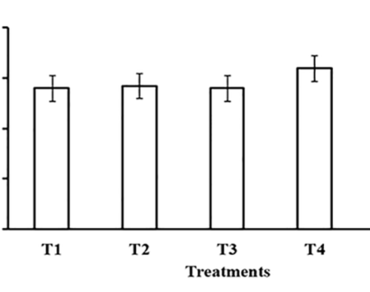Integrated nutrient management improves resistance and resilience of soil biological indicators under subtropical rice-wheat system
Research Articles | Published: 13 April, 2023
First Page: 859
Last Page: 865
Views: 3302
Keywords: Soil enzymes, Microbial count, Permanent plot, Resistance, Recovery
Abstract
Soils are increasingly under an assortment of environmental pressure, often related to the amplification of anthropogenic activities and understanding the response of soil ecosystems to disturbance is a major challenge. Under such disturbances, soil microbes will try to demonstrate their inherent resistance and resilience. It appears necessary to study these responses, given that microbial communities are the key player in providing resistance to the soil system. Keeping this hypothesis in view, an experiment was conducted to evaluate the resistance and resilience indices of soil biological indicators under various sets of long-term fertilization regimes ranging from inorganic to integrated treatments. Soil samples were taken from a permanent plot experiment and exposed to heat stress by putting them at 48 °C for 24 h to quantify their resistance and resilience pattern. Results showed that the resistance indices for dehydrogenase activity was improved by 16% under integrated nutrient management (INM) plots over 100% recommended dose of fertilizers. Acid and alkaline phosphatase activity under INM was increased by 16% and 6% respectively, over recommended dose of fertilizers. Fluorescein diacetate hydrolyzing capacity and microbial biomass carbon followed the same trends under the heat stress condition. Enumeration of microorganisms after stress showed that the microbial groups can combat the heat stress as reflected from positive resistance values under residue application. Recovery of soil biological parameters under integrated plots indicated partial resilience even after three months of incubation. INM improves resistance and resilience indices of soil biological parameters implying its significance under the current agricultural scenario.

References
Biggs CR, Yeager LA, Bolser DG, Bonsell C, Dichiera AM, Hou Z, Keyser SR, Khursigara AJ, Lu K, Muth AF, Negrete B, Erisman BE (2020) Does functional redundancy affect ecological stability and resilience? A review and meta-analysis. ECOSPHERE 11(7):e03184
Blagodatskaya E, Blagodatsky S, Khomyakov N, Myachina O, Kuzyakov Y (2016) Temperature sensitivity and enzymatic mechanisms of soil organic matter decomposition along an altitudinal gradient on Mount Kilimanjaro. Sci Rep 6:22240
Buckley LB, Huey RB (2016) How extreme temperatures impact organisms and the evolution of their thermal tolerance. Integr Comp Biol 56(1):98–109
Chaer G, Fernandes M, Myrold D, Bottomley P (2009) Comparative resistance and resilience of soil microbial communities and enzyme activities in adjacent native forest and agricultural soils. Microb Ecol 58:414–424
Chhonkar PK, Bhadraray S, Patra AK, Purakayastha TJ (2007) Experiments in Soil Biology and Biochemistry New Delhi, Westville
Das A, Sharma RP, Chattopadhyaya N, Rakshit R (2014) Yield trends and nutrient budgeting under a long term (28 years) nutrient management in rice -wheat cropping system under sub-tropical climatic condition. Plant Soil Environ 60:351–357
Griffiths BS, Bonkowski M, Roy J, Ritz K (2001) Functional stability, substrate utilisation and biological indicators of soils following environmental impacts. Appl Soil Ecol 16:49–61
Hammerl VB, Grant K, Pritsch K, Jentsch A, Schloter M, Beierkuhnlein C, Gschwendtner S (2019) Seasonal effects of extreme weather events on potential extracellular enzyme activities in a temperate grassland soil. Front Environ Sci 6:157
Kumar A, Rakshit R, Bhowmik A, Mandal N, Das A, Adhikary S (2019) Nanoparticle-induced changes in resistance and resilience of sensitive microbial indicators towards heat stress in soil. Sustainability 11(3):862
Kumar D, Rakshit R, Rani R, Bharti P, Das A, Kundu M (2022) Integrated nutrient management in coconut (Cocos nucifera l.): an assessment of soil chemical and biological parameters under subtropical humid climate. J Soil Sci Plant Nutr 22:2695–2706
Kumar S, Patra AK, Singh D, Purakayastha TJ (2014) Long-term chemical fertilization along with farmyard manure enhances resistance and resilience of soil microbial activity against heat stress. J Agron Crop Sci 200:156–162
Nandhini DU, Somasundaram E, Somasundaram S, Arulmozhiselvan K. (2021) Soil carbon pool under organic and conventional crop production system of semi-arid tropics. Bangladesh J Bot 50:79–84.
Pimm SL (1984) The complexity and the stability of ecosystems. Nature 307:321–326
Rakshit R, Patra AK, Pal D, Kumar M, Singh R (2012) Effect of elevated CO2 and temperature on nitrogen dynamics and microbial activity during wheat (Triticum aestivum L.) growth on a subtropical Inceptisol in India. J Agron Crop Sci 198:452–465
Raza A, Razzaq A, Mehmood SS, Zou X, Zhang X, Lv Y, Xu J (2019) Impact of climate change on crops adaptation and strategies to tackle its outcome: a review. Plants (Basel) 8(2):34
Vance ED, Brookes PC, Jenkinson DS (1987) An extraction method for measuring soil microbial biomass C. Soil Biol Biochem 19(6):703–707
Author Information
Department of Soil Science and Agricultural Chemistry, Bihar Agricultural University, Sabour, Bihar, India